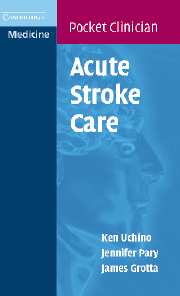Book contents
- Frontmatter
- Contents
- Preface
- List of abbreviations
- 1 Stroke in the emergency department
- 2 What to do first
- 3 Ischemic stroke
- 4 TPA protocol
- 5 Neurological deterioration in acute ischemic stroke
- 6 Ischemic stroke prevention: why we do the things we do
- 7 Transient ischemic attack (TIA)
- 8 Intracerebral hemorrhage (ICH)
- 9 Subarachnoid hemorrhage (SAH)
- 10 Organization of stroke care
- 11 Rehabilitation
- Appendix 1 Numbers and calculations
- Appendix 2 IV TPA dosing chart
- Appendix 3 Sample admission orders
- Appendix 4 Sample discharge summary
- Appendix 5 Stroke radiology
- Appendix 6 Transcranial Doppler ultrasound (TCD)
- Appendix 7 Heparin protocol
- Appendix 8 Insulin protocol
- Appendix 9 Medical complications
- Appendix 10 Brainstem syndromes
- Appendix 11 Cerebral arterial anatomy
- Appendix 12 Stroke in the young and less common stroke diagnoses
- Appendix 13 Brain death criteria
- Appendix 14 Neurological scales
- Recommended reading
- References
6 - Ischemic stroke prevention: why we do the things we do
Published online by Cambridge University Press: 10 October 2009
- Frontmatter
- Contents
- Preface
- List of abbreviations
- 1 Stroke in the emergency department
- 2 What to do first
- 3 Ischemic stroke
- 4 TPA protocol
- 5 Neurological deterioration in acute ischemic stroke
- 6 Ischemic stroke prevention: why we do the things we do
- 7 Transient ischemic attack (TIA)
- 8 Intracerebral hemorrhage (ICH)
- 9 Subarachnoid hemorrhage (SAH)
- 10 Organization of stroke care
- 11 Rehabilitation
- Appendix 1 Numbers and calculations
- Appendix 2 IV TPA dosing chart
- Appendix 3 Sample admission orders
- Appendix 4 Sample discharge summary
- Appendix 5 Stroke radiology
- Appendix 6 Transcranial Doppler ultrasound (TCD)
- Appendix 7 Heparin protocol
- Appendix 8 Insulin protocol
- Appendix 9 Medical complications
- Appendix 10 Brainstem syndromes
- Appendix 11 Cerebral arterial anatomy
- Appendix 12 Stroke in the young and less common stroke diagnoses
- Appendix 13 Brain death criteria
- Appendix 14 Neurological scales
- Recommended reading
- References
Summary
In this chapter, we discuss mainly secondary prevention for stroke, although many of the measures, especially control of risk factors and lifestyle changes such as not smoking, controlling blood pressure, etc., are also important measures to avoid a first stroke.
Initially, we discuss a tailored diagnostic work-up, then general measures for secondary prevention of ischemic stroke, and finally recommendations for specific conditions that are associated with a high risk of stroke.
Investigations
The goal of the “stroke work-up” is to find the cause of the stroke in order to determine the best treatment options to maximize the chance of preventing another stroke.
A thorough ischemic stroke work-up is not just CT/MRI/MRA/ECHO/CAROTIDS/TCD/LIPIDS/HBA1C.
There is no “cookbook” work-up for ischemic stroke. It is important to consider the patient's risk factors and stroke syndrome when determining the extent of the diagnostic evaluation. For instance, a 75-year-old man with longstanding hypertension, diabetes, and hypercholesterolemia and a lacunar infarct confirmed on brain imaging may need little additional work-up beyond a carotid ultrasound and EKG. However, a 40-year-old man with no known risk factors and an acute stroke would require an extensive evaluation.
The following is a list of the studies that we consider in most stroke patients to distinguish stroke subtype and tailor our preventive measures. In Appendix 12 we will address the additional evaluation for young stroke patients with no risk factors, and others where the underlying cause may be more obscure.
- Type
- Chapter
- Information
- Acute Stroke CareA Manual from the University of Texas - Houston Stroke Team, pp. 61 - 84Publisher: Cambridge University PressPrint publication year: 2007



